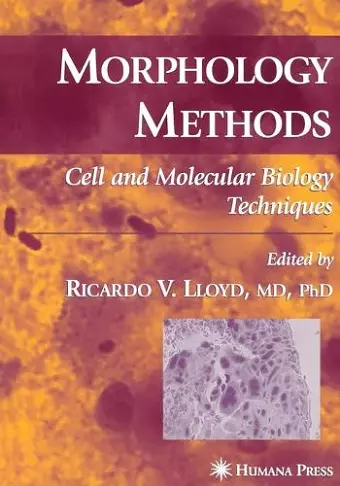Morphology Methods
Cell and Molecular Biology Techniques
Format:Paperback
Publisher:Humana Press Inc.
Published:9th Dec '10
Currently unavailable, and unfortunately no date known when it will be back
This paperback is available in another edition too:
- Hardback£129.99(9780896039551)

Springer Book Archives
The earliest work in the field was primarily in the hands of botanists and many of the approaches to the under standing of the chemical composition of cells and tissues involved techniques such as microincineration, which destroyed structural integrity.The past several decades have witnessed an impressive array of conceptual and techno logical advances in the biomedical sciences. Much of the progress in this area has developed directly as a result of new morphology-based methods that have permitted the assessment of chemical, enzymatic, immunological, and molecular parameters at the cellular and tissue levels. Additional novel approaches including laser capture microdissection have also emerged for the acquisition of homogeneous cell popula tions for molecular analyses. These methodologies have literally reshaped the approaches to fundamental biological questions and have also had a major impact in the area of diagnostic pathology. Much of the groundwork for the development of morphological methods was estab th lished in the early part of the 19 century by Francois-Vincent Raspail, generally acknowledged as the founder of the science of histochemistry. The earliest work in the field was primarily in the hands of botanists and many of the approaches to the under standing of the chemical composition of cells and tissues involved techniques such as microincineration, which destroyed structural integrity. The development of aniline th dyes in the early 20 century served as a major impetus to studies of the structural rather than chemical composition of tissue. Later in the century, however, the focus returned to the identification of chemical constituents in the context of intact cell and tissue structure.
"The book nicely covers the hot topics in this area -- laser capture microdissection, in situ hybridization, FISH, tyramide amplification methods, etc. An attractive feature of this book is that the last 10 chapters (of the 20) contain actual "cookbook" protocols (e.g., PCR, confocal laser scanning microscopy, immunohistochemistry, antigen retrieval, etc.) that can be adapted immediately to any laboratory...This book would be useful for those needing a concise reference for how to perform modern molecular tissue-based technology. " -Doody's Health Science Book Review Journal
"This book describes in detail new methods employed in the study of molecular morphology as a basis for the study of human genes and the etiology of diseases. Among the methods are in situ hybridization, in situ detection of infectious agents, the "FISH" technique, PCR, immunocytochemistry, etc. This excellent production has many photos, some in color, and tables and figures. Very useful to those wishing to employ these techniques." - Journal of Pediatric Endocrinology and Metabolism
ISBN: 9781617372735
Dimensions: unknown
Weight: unknown
422 pages
Softcover reprint of hardcover 1st ed. 2001